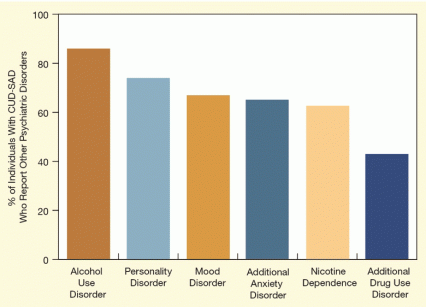
A recent large-scale epidemiological study sheds light on the relationship between cannabis use disorder (CUD) and social anxiety disorder (SAD). The findings affirmed that a significant portion of individuals with CUD also have SAD, and showed that comorbid SAD is associated with greater severity of cannabis-related problems. Moreover, almost all individuals with both CUD and SAD had at least one additional clinically significant psychiatric disturbance.
The researchers say that their findings highlight the importance of assessing CUD patients for SAD. Their evidence suggests that SAD can be both a contributing cause and a consequence of CUD, and that treating both disorders may be a key to helping patients recover from each.
A Common Comorbidity
Dr. Julia D. Buckner at Louisiana State University, Dr. Richard G. Heimberg at Temple University, Dr. Franklin Schneier at Columbia University, and Dr. Carlos Blanco’s team at the New York State Psychiatric Institute analyzed data from the 2001‒2002 National Epidemiologic Survey on Alcohol and Related Conditions (NESARC). Their results confirmed previous observations that patients with CUD experience high rates of SAD.
Of the 43,093 respondents to the survey, 3,297 (7.6 percent) reported having had drug problems consistent with CUD at some time in their lives. Of those with CUD, 340 (10.3 percent) also reported having had, at some time in their lives, social anxiety that was severe enough to warrant a clinical diagnosis of SAD.
Given these numbers, Dr. Buckner says, assessing CUD patients for SAD can facilitate treatment for many. Identifying and treating comorbid SAD can remove an obstacle to recovery from substance abuse. “For example, research suggests that socially anxious people may be less likely to participate in group therapy or seek a sponsor. Also, higher levels of anxiety at the end of CUD treatment have been shown to lead to a higher rate of relapse into cannabis use and related problems,” she says.
The Order of Maladies
Over 80 percent of the NESARC respondents with CUD‒SAD comorbidity reported that their SAD preceded their CUD, and 15 percent reported CUD onset before SAD onset. Based on this observation, Dr. Buckner and colleagues suggest that two alternative pathways can lead to CUD‒SAD comorbidity.
In both pathways, CUD and SAD promote and exacerbate each other. In the more common one, individuals develop CUD as an adverse consequence of self-medicating to ease their social anxiety. In the alternative pathway, uncontrolled cannabis use generates social difficulties and anxiety that develop into SAD.
From a clinical perspective, the researchers say, it will be important to determine whether different pathways indeed exist, because the two groups may respond differently to treatment. For example, those who develop CUD as a result of relying on cannabis to manage their anxiety may benefit from skills to help them better manage their anxiety. In contrast, those who develop SAD as a result of CUD-related impairment may benefit first from strategies to help them better manage their social difficulties and other cannabis-related problems.
SAD and Cannabis Use Severity
Further analysis suggested that people with CUD and SAD experience more cannabis-related problems than those with only CUD. Among NESARC respondents with CUD, 21 percent of those who met the diagnostic criteria for cannabis dependence—which requires compulsive use of the drug and drug-related psychological or physiological problems—also had SAD. In contrast, the rate of SAD among those who met the criteria for cannabis abuse—which specifies only periodic cannabis use and does not require physiological problems—was 8.5 percent.
After controlling statistically for the effects of gender, race, and other psychiatric comorbidities, the researchers estimated that an individual with cannabis dependence had 1.6 times higher odds of comorbid SAD, compared to an individual with cannabis abuse.
Compounded Comorbidities
The patient with CUD and SAD probably has other psychiatric problems as well, the NESARC data suggest. More than 99 percent of the respondents who reported CUD‒SAD also reported symptoms meeting the diagnostic criteria for at least one additional psychiatric disorder (see Figure below). More than 98 percent had experienced another Axis I disorder (e.g., other substance use disorder, mood disorder, or anxiety disorder), and about 73 percent had experienced an Axis II personality disorder (e.g., obsessive-compulsive, paranoid, avoidant, antisocial, schizoid). The CUD‒SAD group’s odds for reporting a third comorbidity were over 7 times higher than those of respondents who had CUD without SAD.
Not surprisingly, individuals with CUD‒SAD reported poorer overall health than those with CUD alone. Just over half rated their health status as excellent or very good, compared to 60 percent of those with CUD alone.
 Individuals With Both Cannabis Use and Social Anxiety Disorders Reported High Rates of Additional Psychiatric Problems In the 2001‒2002 National Epidemiologic Survey on Alcohol and Related Conditions, more than 99 percent of respondents who reported symptoms meeting diagnostic criteria for both disorders also qualified for at least one additional psychiatric diagnosis.
Individuals With Both Cannabis Use and Social Anxiety Disorders Reported High Rates of Additional Psychiatric Problems In the 2001‒2002 National Epidemiologic Survey on Alcohol and Related Conditions, more than 99 percent of respondents who reported symptoms meeting diagnostic criteria for both disorders also qualified for at least one additional psychiatric diagnosis.Clinical Implications
“In drug treatment settings, anxiety in general, but SAD in particular, can often be overlooked because providers are focused on substance use,” says Dr. Buckner. However, addressing patients’ social anxiety in treatment can enhance their chances for successful recovery from substance abuse, as well as improve their general quality of life. A finding that a patient with CUD has comorbid SAD can also alert clinicians to a high likelihood of other comorbid problems.
“The relationships among anxiety disorders and substance use disorders are complex and merit this kind of attention, given how commonly they co-occur,” says Dr. Naimah Weinberg from NIDA’s Division of Epidemiology, Services, and Prevention Research. “This type of study, with the power to focus on a particular anxiety disorder and type of substance dependence, helps refine our understanding of these complex relationships. If the results can be replicated, particularly by prospective studies, this may offer an opportunity for intervention with high-risk youth to prevent the development of substance use disorders.”
This study was supported by NIH grants: DA019606, DA020783, DA023200, MH076051, DA019606-01A2, DA020783-01A1, and MH076051-01A2.
Source:
Buckner, J.D.; Heimberg, R.G.; Schneier, F.R.; et al. The relationship between cannabis use disorders and social anxiety disorder in the National Epidemiological Study of Alcohol and Related Conditions (NESARC). Drug and Alcohol Dependence 124(1–2):128–134, 2012. Full Text
